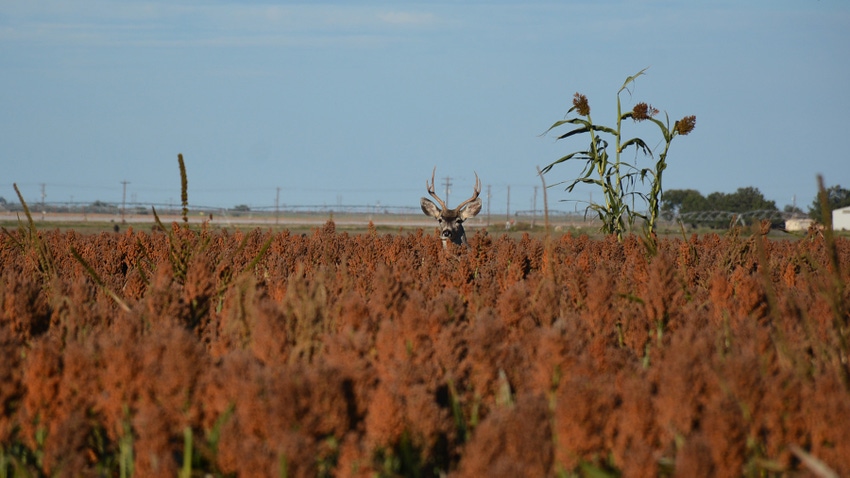
From the Coastal Bend to the Panhandle, hunters across private and public lands will take to the field as general white-tailed deer hunting season opens Nov. 4 in Texas.
While the thrill of the hunt and anticipation of a successful harvest sits at the forefront of every hunter’s mind, Jacob Dykes, Ph.D., Texas A&M AgriLife Extension Service wildlife specialist, Corpus Christi, said it’s imperative hunters never lose sight of the most critical aspect of the season—safety.
Texas experienced one fatality and 14 non-fatal hunting-related incidents in 2022, according to the Texas Parks and Wildlife Department. This is a far cry from the 12 fatal and 28 non-fatal incidents reported in 1988, the year the state’s mandatory hunter education program was implemented.
“Hunter education across the U.S. has made a big impact in reducing the number of hunting-related injuries, but accidents still happen,” said Dykes, an assistant professor in the College of Agriculture and Life Sciences Department of Rangeland, Wildlife and Fisheries. “It’s important that hunters of all experience ranges regularly refresh themselves on key precautions leading up to opening day.”
Firearm safety reigns supreme
Firearm safety is a primary concern, especially considering many hunters may traverse rugged terrain or dense underbrush to reach their selected hunting spot. This creates the opportunity for accidental discharge caused during a fall or snag on vegetation.
Dykes recommends not loading a round in the chamber until you are settled at your hunting location and adhering to the following guidelines:
Treat all guns as if they are loaded: While experienced hunters and firearms enthusiasts establish a level of comfort with the mechanisms of their weapon of choice, Dykes said one must never be complacent when handling a firearm. By treating all firearms as if they are loaded, hunters maintain an appropriate level of caution to ensure their safety and the safety of everyone around them.
Always keep firearm pointed in a safe direction: The muzzle of a firearm must always be under control. Never point a muzzle at anything unless you are intending to shoot.
Do not place your finger on the trigger until you are ready to shoot: In addition to keeping the gun safety engaged until ready to fire, hunters should never place their finger over the trigger until they have confirmed their target and are ready to shoot.
Always be sure of your target, as well as what lies beyond it: Never shoot in the direction of sound or movement. A hunter should always identify the game animal and determine what lies beyond the animal before they proceed with their shot.
Beyond firearm safety
In addition to the importance of proper firearm handling and safety, Dykes said hunters should incorporate several other safety precautions leading up to and during the hunt.
“Remember, as a hunter you are exposing yourself to the natural elements, which can be challenging,” Dykes said. “Furthermore, in many cases, hunters are positioning themselves 10 to upwards of 20 feet off the ground in deer stands. This requires added caution and maintenance to ensure safety.”
Check and replace deer stand straps as well as ladders and restraints on blinds: A 2022 study determined that falls from tree stands were the primary cause of deer hunting accidents in Pennsylvania, surpassing deer hunting-related shooting incidents. This underscores the importance of ensuring all straps and restraints on stands and ladders are properly secured and in good condition.
Wear a safety harness when hunting from a deer stand: Even if deer stand straps are secure, a single misstep can result in a dangerous fall. Wearing a harness and connecting to a secure lifeline keeps hunters safe ascending the stand, while hunting and descending.
Be aware of snakes during warmer periods of hunting season: Texas can experience warm weather long into the hunting season. During these warm periods, snakes—including the roughly dozen venomous species found in Texas—are active. Dykes said general awareness of where you are stepping or placing your hands is key to avoiding negative encounters.
Use insect repellent while hunting: In addition to pests such as mosquitos, ticks can be a scourge on many hunters. While ticks are most active during spring through fall months, they persist throughout winter. Insect repellent is key to avoiding tick-borne illnesses such as Lyme disease and alpha-gal syndrome.
Carry plenty of water and dress for the elements: Even in cool weather, dehydration is a possibility—especially when engaged in strenuous activity such as hiking and climbing deer stands. Many backpacks now include sleeves for water bladders of varying sizes that can provide hydration throughout a hunt. Additionally, be aware of forecasted weather during hunting expeditions and pack or wear weather-appropriate gear. Individuals hunting on public lands in Texas must also adhere to Texas Blaze Orange Laws requiring hunter orange material and headgear to be worn.
Let someone know where you will be: Hunters should always let a close friend or family member know where they plan to be, as well as when they plan to return. In the event of an accident or emergency, this saves critical time in locating the hunter.
“With a bit of deliberate planning and mindful actions in the field, hunters can help ensure a safe and memorable hunting season,” Dykes said.
About the Author(s)
You May Also Like




